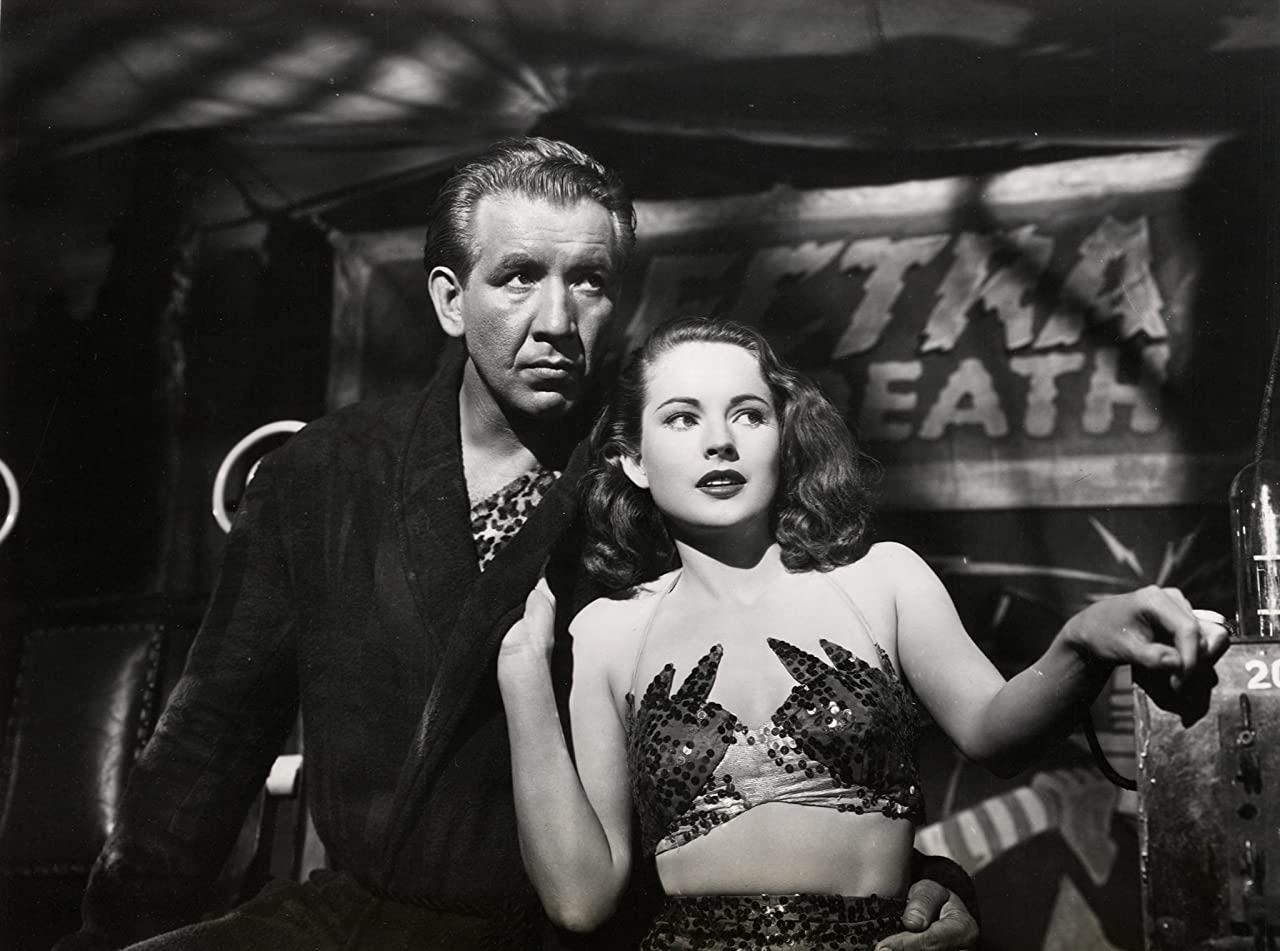Nightmare Alley (1947): A Grim & Unique Noir Gem
Something dark, twisted, and great to close out #Noirvember? This is your ticket.

This year is the first time I noticed #Noirvember trending on social media platforms with strong film followings, like Letterboxd and Twitter. I have a soft spot for the genre, so I lined up a handful of classic film noirs that I’d never got round to watching, and made my way through them early in the month.
My interest tapered off, finding each disappointing in different ways — not living up to what I imagined, even if they are featured near the top of most “greatest noirs of all time” lists. Some seemed stilted, forced, or emotionally empty. Too boxed in to their genre conventions, maybe. I won’t list the titles for fear of merciless onslaught from cineastes with a love of hardboiled fiction and a grudge to settle, but they were big ones. Even the noirs I could appreciate as great films weren’t hitting the spot. It happens.
Part of the problem is that when I think of noir, the two films that spring to mind are The Third Man (1949) and Casablanca (1942) (some argue against the latter being included in the genre, but for me, any black & white movie made around the time of WW2, making use of low-key lighting, and — crucially — infused with a deep and weary cynicism, is noir). Those are two of my all-time favourite movies. They can stand shoulder to shoulder with any other movie ever made, in any genre. Nothing will ever compare to them.
Abandoning the idea of discovering a mythical third noir masterpiece (I think Touch of Evil comes about as close as possible, as an aside, but I’m already familiar with it), I took another run through “top noir” lists later in the month. Nightmare Alley (1947) jumped out.
It sounds like a 1980s horror film that fell through time and landed in the late 1940s post-war rubble as a black and white… dark crime story in a circus carnival?
Directed by Edmund Goulding, a British director who was better known for making cultured dramas starring Greta Garbo, Bette Davis, and Tyrone Power (who stars here, cast out of type), Nightmare Alley is an oddball noir that actually had a big budget for its genre at the time (the lighting and photography leave something to be desired, but it has impressive sets and a great cast).
The film twists and distorts the typical down-on-your-luck crime story archetype, staging its tale in a carnival, and goes to grim and fateful places from there. It’s about swindling, con-artistry, spirituality, fate, and the kind of immoral actions that provoke the “hand of God.” Falling low and trying to rise high. Almost all darkness, with a bit of light. It’s great.
Tyrone Powers plays Stan Carlisle, a newbie carny with a deficiency in moral fibre and an abundance of hubris and ambition. The story of his character is also, on another level, that of the fool with pretensions, who sets his sights higher than he can reach, welcoming a tragic outcome. He is, in short, a charlatan of the first degree (which was the film’s title in some countries), and more (to paraphrase Popeye).
Stan has a talent for learning the kinds of social confidence tricks and deceptions that allow carnival games to attract punters and part them from their money, but he practises these skills with a lack of boundaries that makes his behaviour quickly feel sociopathic. He takes already-dubious skills and applies them with immoral relish.
"See how easy it is to hook them?"
To stall a cop who has been sent to close down the carnival, he puts the con on him — prying into his fears and insecurities, strained personal relationships, even his role and purpose in the world. He makes him emotional to soften him up, walking him down the proverbial “garden path,” and sending him away shaken and confused with an insincere pat on the back and a false air of having helped him.
Technically this creates a distraction and helps his carny friends, but the way he does it — and takes pleasure in the deception — has an unsettling quality. He lights up like a church on Sunday when he gets his hooks in. His initial cons aren't seriously immoral, but foreshadow what he is capable of. He also confides in Zeena, a practised carny and tarot card reader, that for him the attraction of working in the circus is the feeling of superiority over the rubes who patronise it. He is clearly on an ego trip that could lead to dangerous places — we’re just not sure how far the rabbit hole goes.
Stan Carlisle is a deeply immoral character for a protagonist, even for film noir. He gives the film a darkness that actually generates some of the horror vibes the movie’s title conjures.
When the film was released it was a flop, received negatively by the public in part due to seeing Tyrone Powers, a star known for romantic swashbuckling roles, play such a loathsome man. His performance is superb. It reminds of Paul Newman from The Hustler (1961)—though Eddie is more of a positive mirror reflection of Stan, they share similar mannerisms and traits.
A tidbit that I found too interesting to leave out: the Tyrone Powers who appears in this film was, incredibly, the third of four Tyrone Powers, in an acting family dynasty going back to the eighteenth freaking century!
Part of the film's dark fascination is the morally uncertain, carnivorous atmosphere of the carnival which Stan is getting acquainted with in the opening scenes. Everything is a con of one kind or another, the circus a collection of misfits who can't play by normal rules. A no man's land for the strange, unfortunate, and damaged - who are mostly alcoholic or living with mental disturbances in unhealthy surroundings. It makes a striking impression of a 1940s carnival.
Carny culture swirls with mystery and intrigue. Ominous tarot cards falling off tables, alcoholics falling apart at the seams, adultery and dubious sexual relationships at every turn. Drama everywhere. It feels like a dangerous world to navigate. Some of the carnies are worn out through long-term exposure to it.
Pete, an alcoholic in physical ruin, is predicted by the tarot cards to imminently die. The geek, who represents ultimate failure, the lowest and most humiliating role in the circus, is insinuated to be barely recognisable as human, and suffers psychotic fits. Euphemisms and 1940s anachronisms are used liberally in the script. Pete has "the dropsies." The geek gets the "heebie-jeebies."
The circus attraction holding the most fascination for Stan is the geek. This "performer" is not shown on camera initially (and only from behind, at a distance, later) but is described to the leering audience as a monster with a beastly mind, who will eat anything he is fed. His "handler" throws him live chickens to prove the point, which the audience's reaction implies he devours raw. Stan stands in the audience, transfixed. He asks how a man can fall so low to agree to perform this role. Another carny snaps back that he needs to learn not to ask so many questions.
We find out later that if the geek does not "play the part" he is abruptly cut off from the alcohol he is physically dependent on, sending him into alcoholic delirium. He is essentially captive, and events make us realise that circus performers have good reason to refuse to work in carnivals that feature a geek attraction. What is presented glibly to the public as a subhuman beast may actually be someone who has, one way or another, fallen into a desperate low they cannot pull themselves out of. Possibly of their own doing, and possibly due to mental health issues and/or alcohol dependency - making them vulnerable to being exploited, even by those closest to them.
It's the geek. He's got the heebie-jeebies again.
The script is written with a literal and didactic moral that is very of its time. Over-ambition is suggested as a kind of ultimate sin, which probably speaks to the immediate post-war mentality, and the lessons society felt they had paid so dearly to learn.
Stan's trajectory, tracking his fast rise through the world of the circus, and his onward journey into upper society where he continues to pursue the manipulation and exploitation of those around him, structures the narrative. The success he achieves as a "miracle worker" of some fame precipitates an inglorious fall (that we see coming).
About half the film takes place outside the carnival, where the upper class dine in fancy night clubs and pray ponderously in expansive estate gardens adjoining mansions equipped with teams of servants (who are under orders never to enter these gardens). This gives a second view on 1940s society that contrasts strongly with the carnival.
A love story runs parallel to Stan's rise and fall. Molly (Coleen Gray) is a young carny hand with a good heart. She falls for Stan - duped, it seems. Stan plays around with Molly's heart, putting the con on her like he does everyone else. It's the story of the good woman who, against her interests, falls in love with a bad man. Coleen Gray performs the role brilliantly. Molly's complicity with Stan feels at once inexplicable and like a believable representation of love when mixed with youthful naivety. Molly is a sympathetic character in a helpless situation, and a source of crucial moral and dramatic conflict.
In a pivotal scene that takes place in the garden of a luxurious estate, described as "cathedral like," the dialogue focuses on the lofty question of what it means to do good. The core thought is that good works ("like prayer") should be done in secret. Stan understands this concept perfectly, we see. He can quote the bible as well as anyone, and has chosen his path knowingly. This scene is superb, and leaves a lasting impression. You could say it's the equivalent of the samurai sword fight in the snow garden of Kill Bill: Volume 1 (2003) (but, no samurai swords).
The film has fate, destiny, tragedy, swindling, hubris, evil, and deceit. Alcoholism, psychology, and spirituality are all tackled in compelling ways. There is also a terrific femme fatale in Lilith (Hellen Walker), a female psychologist who plays an important role in the story, and who alludes to the film's title in her dialogue. It is a relatively brief but dynamic performance.
The story is focused on ideas of fate. Rising up in the world, falling low. The part God, spirits, or greater powers play in events, and whether people are born destined to certain outcomes. This gives it mystery and intrigue.
A unique and off-beat noir, full of dark and frightful energy, menacing atmosphere, and big themes. It has great performances and highly memorable characters. If that sounds like it would float your boat, you could do worse than to watch Nightmare Alley (1947) in the closing days of #Noirvember.
Bonus! Guillermo del Toro's next movie is a 2021 remake, with Bradley Cooper playing Stan Carlisle and Cate Blanchett as Lilith, the femme fatale. It's set to be released late December, and as far as the trailer shows it will be as visually spectacular as you'd expect from del Toro. Here's hoping for something great.
James Lanternman writes movie reviews, essays, and moonlit thoughts. You can reach him at [email protected].
Previously… The Last Duel (2021): A Movie Review
